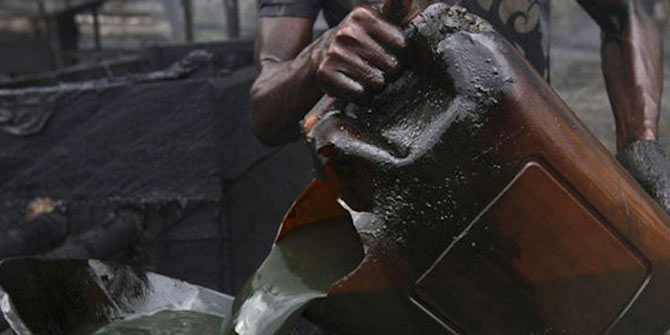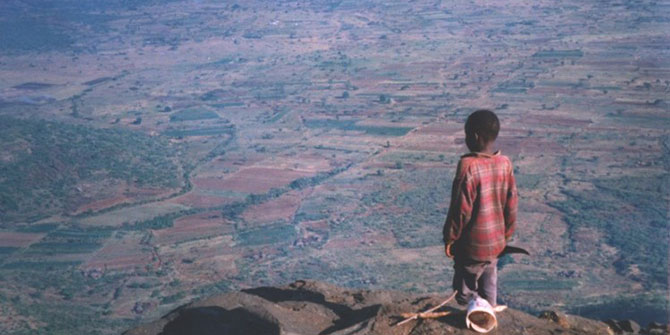As economist and author, Dambisa Moyo visited LSE to discuss her new book, Winner Take All: China’s Race for Resources and What it Means for Us, she says it is time for the world to wake up to the fact that commodity scarcity is fast approaching and prepares to deal with it.
[jwplayer config=”lse” image=”https://blogs.lse.ac.uk/africaatlse/files/2012/07/Dambisa_Moyo_0211.jpg” file=”http://media.rawvoice.com/lse_publiclecturesandevents/richmedia.lse.ac.uk/publiclecturesandevents/20120625_1830_winnerTakeAll.mp4″]
Watch Dambisa Moyo’s lecture at LSE on Monday 25 June 2012
It was to a packed theatre here at LSE that the Zambian economist and author, Dambisa Moyo expanded on her latest offering, Winner Take All: China’s Race for Resources and What it Means for Us.
There is a race for the world’s resources, she asserts, and China is way ahead of everybody else. Moyo said it was only while serving on the board of certain oil and gas and mining companies that she realised she had absolutely no clue about what was going on. We never think of the billions of dollars that go into bringing us bottles of water or lives lost in the exploration, development and production of the minerals that go into our mobile phones. She was quite puzzled that such a huge issue was not on the global agenda, particularly given that it is centred around components essential for human survival: food, water, energy and minerals. This is what motivated her to do some research.
China is often criticised for “pillaging” the world, but Moyo suggests that it is way ahead of the game and realises that the world’s resources are going to run out at some point.
She identified three areas of China’s commodity demand. Given that the population is projected to grow from seven billion people today to nine billion by 2050, more people will want more things.
An increase in wealth is also likely as 90% of the world’s population live in emerging markets. With three billion in the middle class by 2025, these will want better access to water, seek a variety of foods as well as some of life’s luxuries like televisions and cars. The third aspect is expected to be urbanisation as an extra three billion people are expected to be living in urban areas by 2020.
Moyo describes demand as only one-half of the story with supply being the other half with land, water, energy and minerals on the menu.
There are 30 billion hectares of land in the world, but only 10% of that is arable. Africa has the most untilled arable land on earth. China has a population of 1.3 billion, yet only 10% of its land is arable. So it has to look outwards to feed its population. Moyo pointed to USA and Brazil who are growing soybeans rather than other crops to fuel China’s huge demand.
Even though 70% of the world is water, less that one percent is readily accessible to us for drinking and sanitation. Most of it is too salty and desalination is a big problem. China has significantly below the world’s average of water per capita and is pursuing an aggressive policy to procure more. This includes blowing clouds into the sky to create rain and re-routing entire rivers.
Moyo declared that she was shocked when she found out that the world is living off energy sources discovered in the 1950s, despite all the technology at our disposal. Not much effort is being made to find new sources of oil, fossil fuels etc. Even the new sites of oil being discovered have actually been discovered before.
In talking about minerals, Moyo provided an astonishing statistic that the amount of copper in mobile phones discarded in USA in just one year was equivalent to 50 Boeing 747 jets. China, meanwhile, consumes 40% of the world’s copper today.
China is satiating its vast appetite by pursuing relationships with those whom Moyo calls the axis of the unloved, in other words, regions around the world that have been bereft of investment, particularly from Western economies. This includes not just Africa, but also countries in South America like Chile and Brazil as well as Russia and Kazakhstan in Eastern Europe.
In addition, we see the Chinese governments providing capital to their companies to go out and do business abroad as well as becoming the price-setter for resources based on them being the key buyer of many products.
China is the very clear leader in this race for the world’s resources, but what about “us”?
According to Moyo, it is time the world rallies around this issue and takes a more multi-lateral approach to commodity scarcity. She suggests that if USA took a fraction of its defence budget and put it into innovation, it would go a long way to solving the problem.






1 Comments